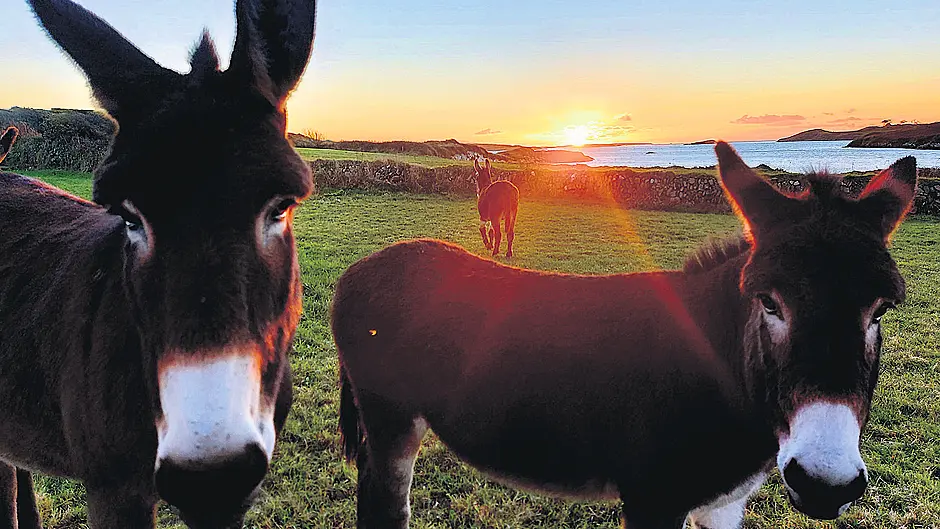A TRIO of gorgeous donkeys has arrived in this townland and they already recognise me as a ‘bringer of treats’ because, like many others, I’m a sucker for a good-looking donkey.
Donkeys were once ubiquitous in West Cork, serving us well as humble beasts of burden, carrying seaweed, turf, provisions and drawing churns of milk to the creamery. Docile animals, they were regarded as a farm tool by local farmers rather than objects of affection.
However, generations of children loved their farm donkeys, myself included. And even the smell of donkey evokes many happy childhood memories of riding my pet donkey Jackie around our farm.
And these animals also have a strong association with this season, featuring in Nativity scenes and traditional Christmas cribs.
Arrival in Ireland
It’s believed that the modern donkey is a descendant of the wild ass of Africa, a native of Somalia and parts of the Sudan. This species was domesticated by African and Middle Eastern traders as a beast of burden and was probably subsequently interbred with the wild ass of Asia.
It’s unclear when this animal arrived in Ireland but it seems to have been uncommon until about 300 years ago. There is a 12th century reference to a donkey in an account about a journey here by a cardinal from Rome, but it seems that it was as late as the 18th century before it came into general use in Ireland. But over the following two centuries it came into widespread use by small farmers all over Ireland.
Folklore, cures and myth
In Ireland, the donkey was regarded as blessed as the animal that carried Christ into Jerusalem, and was said to have been awarded the cross on its back as a result.
It played a starring role in the traditional cribs that were a feature in most Irish homes, and was always given a good feed at Christmas time on the strength of this association.
As well as its role in transportation and farm work, the donkey was utilised in other ways too. Donkey hide was used as leather for making drums and shoes, and donkey milk was also widely consumed.
The donkey also featured in a lot of folk cures. It was believed that a donkey’s milk was a a cure for ‘consumption’, whooping cough andgout. A hair from the cross on a donkey’s back was believed to remedy the murrain in farm cattle. Scarlet fever was also supposedly eased by putting a hair from an affected person down the throat of an unfortunate donkey.
And passing a patient under the belly of a donkey was a treatment for whooping cough and epilepsy.
These ‘cures’ really give an insight into how close this animal was to our ancestors.
And the donkey featured in myth too and most people in West Cork are familiar with the tale of King Labhra Loinnseagh of Lough Ine who was born with the ears of an ass. The king cleverly disguised this affliction from his subjects by carefully arranging his hair to hide his abnormality. And after he got his annual haircut, the unfortunate barber would be executed so as not to reveal the king’s secret.
However, one year as the barber lay dying, he managed to whisper the secret to a reed. The reed was subsequently cut down to make a flute to be played at the king’s banquet.
When the flute was played it sang out the secret: ‘King Labhra has the ears of an ass’ and the king was disgraced and was forced to abandon his kingdom.
There are many variations to this legend and the wonderful Lough Ine local historian Neily Bohane (now sadly deceased) was famous for his recitation of this saga.
Unfortunately it’s too long to reproduce in its entirety but we’ll feature one verse of it in Neily and King Labhra’s honour:
‘T’was King Labhra O’Loinnseagh as he was then known,
Had this huge castle built of mortar and stone,
For he was Lord of the Carberies then
And he had in attendance five score of men.
T’was on tall Cnoc Cauma he hunted the deer
With his kinsmen and classmen twice in the year,
And when the day of the chase and the sport it was o’er with
He invited his friends to be guests at his court
And it couldn’t be said that there was lacking of wine,
There were cellars to hold it in the halls of Loughine.’








